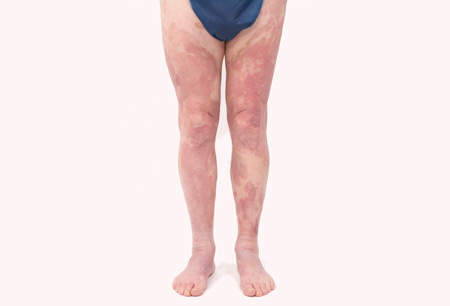Summary
Definition
History and exam
Other diagnostic factors
- pruritus
- hypopigmented/hyperpigmented skin lesions
- unilesional acral site involvement
- lymphadenopathy
- constitutional symptoms
- palmar-plantar keratoderma
- alopecia
- leonine facies
- onychodystrophy
- hepatomegaly
- ectropion
- bullous, granulomatous, ichthyosiform, and purpuric lesions
Risk factors
- age >50 years
- male sex
- black ethnicity (MF); white ethnicity (SS)
- exposure to infectious agents
- ultraviolet light exposure
Diagnostic investigations
1st investigations to order
- FBC
- skin biopsy
- clonal T-cell receptor rearrangement
- flow cytometry
- comprehensive metabolic panel
- LFTs
- serum lactate dehydrogenase
Investigations to consider
- screen for Sézary cells on blood film
- human T-cell lymphotropic virus (HTLV)-I/2 serology
- bone marrow biopsy
- lymph node biopsy
- CT scan or PET
- HIV test
Treatment algorithm
Contributors
Authors
Robert A. Schwartz, MD, MPH
Professor and Head
Department of Dermatology
Rutgers New Jersey Medical School
Newark
NJ
Disclosures
RAS declares that he has no competing interests.
W. Clark Lambert, MD, PhD
Professor and Associate Head, Dermatology
Director, Dermatopathology
New Jersey Medical School
Newark
NJ
Disclosures
WCL declares he has no competing interests
Acknowledgements
Professor Robert A. Schwartz and Professor W. Clark Lambert would like to gratefully acknowledge Professor Tim M. Illidge, Dr Richard Cowan, and Dr Eileen Parry, previous contributors to this topic.
Disclosures
TMI, RC, and EP all declare that they have no competing interests.
Peer reviewers
Chris Kelsey, MD
Assistant Professor
Department of Radiation Oncology
Duke University School of Medicine
Durham
NC
Disclosures
CK declares that he has no competing interests.
Peer reviewer acknowledgements
BMJ Best Practice topics are updated on a rolling basis in line with developments in evidence and guidance. The peer reviewers listed here have reviewed the content at least once during the history of the topic.
Disclosures
Peer reviewer affiliations and disclosures pertain to the time of the review.
References
Key articles
Gilson D, Whittaker SJ, Child FJ, et al. Joint British Association of Dermatologists and UK Cutaneous Lymphoma Group guidelines for the management of primary cutaneous T-cell lymphomas. Br J Dermatol. 2019 Mar;180(3):496-526.Full text Abstract
Willemze R, Hodak E, Zinzani P, et al; ESMO Guidelines Working Group. Primary cutaneous lymphomas: ESMO clinical practice guidelines for diagnosis, treatment and follow-up. Ann Oncol. 2018 Oct 1;29(4 suppl):iv30-40.Full text Abstract
National Comprehensive Cancer Network. NCCN clinical practice guidelines in oncology: primary cutaneous lymphoma [internet publication].Full text
Reference articles
A full list of sources referenced in this topic is available here.
Use of this content is subject to our disclaimer
